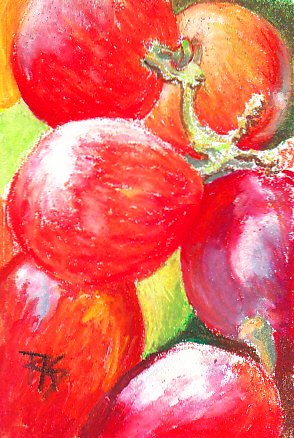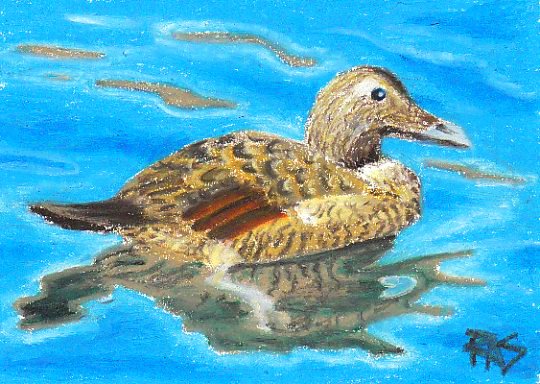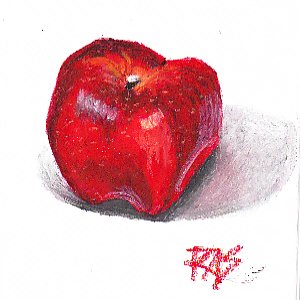|
Rumination
Rumination is thinking about painting or drawing. It's not a waste of time. Teachers may have disciplined you in school for staring out the window daydreaming but that's only because they couldn't tell whether you were staying on topic or paying attention to them. Unfortunately for most people's creativity, that school practice tends to disrupt a natural process essential to artistic growth. Rumination starts with observation. Have you ever really looked at grapes in sunlight when the light's coming through them? It's weird how the light flows through the translucent fruit. Some of the darker areas have a light bluish haze on them while other areas are clear pure color. The shading on red grapes is amazing, it runs from green through all the yellows and oranges to deep red-purple sometimes. I've been fascinated by red grapes with light behind them all my life. I can remember being a grade school kid seeing red grapes in the school cafeteria and being amazed that grapes came in that color -- up till that point I thought there were only the "white" grapes that were actually light green and purple grapes that were actually dark blue. I was a bit annoyed and cynical about things being called colors they weren't at that age. But I stared at those grapes and daydreamed about being able to draw them -- really well -- exactly the way they looked. I was picking out crayons in my mind as I looked at them. That particular part of the fruit would be Persimmon and next to it some Red-Orange while the lighter part would be Yellow Ochre, not Yellow-Orange because it was a bit too greenish-muted. I was thinking in those terms even as a little kid because I got labeled a prodigy and so I got showoff value out of knowing the difference between Vermilion and Viridian. When you imagine drawing or painting a subject, you're getting in real practice rendering it. You're sharpening your memory to a level where someday, having paid attention to it years before, you will be able to remember that brief vision clearly enough to draw it again entirely from memory. Rumination isn't just visual, it can be verbal too. When you articulate those daydreams, put it into words and keep telling yourself "Vermilion is the red-orange one and Viridian is the blue-green and they're twins across the color wheel, complementary which isn't complimentary" the way I did hundreds of times at that age. Then you will be able to understand how to render the things you see realistically or in any other style you want to. I know that memorizing the word Viridian led me to think of using Viridian mixed with some light gray to depict verdegris on copper, and that I used the Viridian crayon to color in a statue in a coloring book at school. When the teacher said it was supposed to be bronze, I told her it was copper and it turned green with age. She was satisfied and let me get away with my green statue. Mental Practice is Real PracticeRumination is essential in visual art, with or without the verbal subtext. That mental practice is what sharpens observation. It's a habit easy to fall into no matter what you're looking at. Just glance at whatever's in front of you that most takes your interest. Here's one of my typical momentary ruminations: I just looked at a golden-amber pill bottle used as a pencil cup on my desk with 24 Col-Erase pencils, a couple of brushes and a graphite pencil in it. The blue-violet pencil with its shiny brass eraser grip and pink eraser on the end attracted my eye. I am looking close at the brass bit on the end and seeing that I'd use Naples Yellow, Yellow Ochre, a bit of the warm pink for the eraser over the yellow ochre where it's reflecting the eraser of a pencil next to it and Indigo Blue for the blue band in the middle of the brass. By running through it like that and picturing myself drawing it very large, I'm also paying attention to the shapes of the highlights and dramatic shadows on the brass. It's a simple set of values, three very distinct shades of light and dark that have different hues because one is the reflection of something else. I can see on the shaft of the pencil that the shadow side is one value step darker than the lit side of the hexagonal pencil. The difference is stronger on the Peach pencil, where the shadow's about four value steps darker. I put all that into words because I'm also a writer. I ruminate on how to describe things as often as I do on how to paint them, usually at the same time. But if all I did was look away and try to remember exactly what those pencils looked like, I would still be closer to getting it right than before looking at them. Rumination is a type of drawing or painting practice you can do anywhere at any time. While you're talking to a friend in IM, glance up at something on your desk and imagine drawing it perfectly in oil pastels. Decide in your mind which ones you'd use -- which brand, which colors, what surface. Envision yourself painting it perfectly as if you were so good that it would come out exactly as you wanted every time. It's important in rumination to imagine yourself doing it perfectly. For one thing, this rehearses for the actual process. The more real experience you have with the materials, the more likely that fantasy painting will be very accurate to what you could do with the real pastels. That's why to get detailed -- to decide whether Holbeins or Senneliers or Pentel would be better for doing it. Decide what style you want to paint while you're ruminating. It doesn't have to be realism either. I looked at the face of a pretty woman in 1985 and remember imagining painting her in wild bold Impressionist strokes exactly as if I was Renoir -- I was remembering Renoir's colors because I'd just visited the Art Institute in Chicago and the sun fell on the lady's face just perfectly with her head tilted back to remind me of his paintings. Years and years later, I was able to loosen up and render things with loose directional strokes like Monet and Renoir, and pay attention more to the light than anything else. 
Rumination Sharpens ImaginationYou don't have to be realistic in your daydreams. You don't have to stick to what you know or even what you see in rumination. You can look at a knot on the wall, see a face in the wood grain and imagine yourself drawing the face with an oil pastel as a loose cartoon -- and getting it perfectly right because in your head you are already a god of art. The reason why this matters so much is that it puts your head in advance of those trainable animals at the end of your arms. Your hand may not yet be trained to do a curve as perfect as the cheek of that loved little girl, but if you look at her with loving eyes and also imagine yourself drawing that young face perfectly as if you were Leonardo... the fantasy will have all your real experience behind it. You may not always realize it but you'll also imagine how you're holding the pencil to get the line, how you'd hold it differently if you were shading around her lips. You may notice things like the shadowed, darker color of her upper lip and the highlight of her lower lip because you're imagining drawing her. All this is essential rumination that will make your next drawing of a little girl a lot more accurate and beautiful. Observation is the key to realism. Accurate rendering is a skill even the most abstract artist can use to know exactly how to simplify it, change it and distort it. Rumination helps for abstraction too. What if you looked in the mirror and before shaving or putting on makeup or whatever you do, imagined yourself painted in two bright flat complementary colors the way Andy Warhol would do it? You'd pick out your two pop art colors. You'd wind up seeing exactly which shadow areas to use the cool color for and which areas to use the warm color for. When you sit down to try one of these two-color pop art exercises even years later, whether you remember that mental exercise in front of the mirror or not it will affect how well you pick out those specific odd shaped shadows.

Rumination Helps to Remember LessonsI was inspired to paint that red Delicious apple from life because of thousands of ruminations on drawing dark red Delicious apples. As a child I was fascinated by their color and shading, it was the most beautiful dark red I could imagine. I thought it was weird that it'd be lighter where the stem is and tried sometimes to memorize the bumps and scars on it. I even tried to remember to put highlights on shiny apples, though usually only remembered afterward when I was a kid. Then just a few days ago, I watched a colored pencils video on painting a Red Delicious Apple in Prismacolors. The artist, Alyona Nickelsen, used a specific technique to put in the light colored dots and speckles that show especially in the dark areas. I hadn't noticed those specks before I saw it in the video, but I remembered the video when I looked for something to paint. I ruminated on oil pastels during the colored pencil painting lesson. I thought about how to put the specks in if I was using oil pastels rather than colored pencils. I thought of the idea of painting the apple in Sennelier oil pastels while watching Ms. Nickelsen paint it in colored pencils. This would work the way her methods do. That would work better the way I do it in oil pastels. I made a lot of minor artistic decisions about that small 4" square painting long before I set out the real apple and painted it from life. Because I decided to paint it after watching the video, I retained a lot more information from the video than I would if I'd just watched it and gone on to do something else. So when you are reading or watching an art lesson, it's okay to think about applying it whether you do it exactly the way the teacher did or some completely you-way the teacher wouldn't have thought of. Most teachers are pretty happy to hear about having inspired someone to try something different! If you ruminate on a serious painting, you can draw a lot of different studies that relate to the big complex painting. Draw or sketch everything you'll use in it by itself -- say, the big painting is going to be a landscape with mountains and a flowered meadow and trees and a beautiful young nude resting in the clover. You're not likely to get a girl to lay nude in prickly weeds on a mountaintop anyway even if you pay her a lot of money, that's asking a lot from a model. But when you look at the mountains, whether that's on vacation or in a photo reference, you can imagine the nude there. Maybe the girl in your imagination didn't look like your model. So you wind up deciding things like hair color and sunlight on skin tone by looking at a lot of different people and may even set out a brown plastic manikin on a bit of green towel to get her pose right-- and all that can work together to create a vision that you couldn't have possibly arranged that well in reality. Maybe the girl in your vision was painted by a seventeenth century master and is long dead... but you can remember the curve of her limbs and the look of her mouth and bring her back to life in your painting in a pose different from what that Old Master put her in. You can create visual fiction when you do that and avoid a heap of trouble in setups for things that can't be controlled. Try getting a model to stand out in a thunderstorm wearing three strips of transparent blowing gauze and waving a copper wizard's staff over her head with lightning flaring off it. You're not going to want your poor model fried on the spot with a lightning strike because she's not really a sorceress. But you do want that illustration to come out right. So every lesson you ever took in illustration and rendering may come back to you as you arrange the scene in your mind. Chapters on composition or values may come to mind naturally as you visualize her turning with her scanty outfit blowing dramatically in the wind -- or if you're going to be more realistic and less conventional, plastered against her leg by real rain while her wild hair slithers down wet skin instead of blow-dried in the wind. I may do that one sometime -- the Frazetta mixed with Realism painting of a storm sorceress. The process of planning major works involves a lot of rumination. So the next time someone sees you staring out the window and thinks that you're doing nothing, remind them that you're accomplishing something important. Great art flows from imagination as much as from your eyes and fingers. The more you let your imagination play, the more intense, skilled and powerful your painting will become. This mental practice does apply to all the arts too. I ruminate my novels constantly. They begin as a daydream with an adventure element, proceed till I reach the keyboard and start developing into stories I tell. I learned how to daydream with my fingers moving to narrate on screen and that's how my rough drafts get finished. Dancers, athletes, musicians all talk about mental practice sharpening their faculties and skills. Musicians hear the music in their heads before they write it in musical notation or play it on an instrument. The more you practice visual art, the more often and naturally you'll see interesting things -- and think of exactly how they'd look painted or drawn by someone a lot better than you are. Because that someone a lot better than you are-now is the you that will be there to paint it later on who has more practice, the materials and skills at hand to do it the way you first saw it. Every good idea returns again and again. I wanted to paint reef scenes in realistic detail ever since I watched Jacques Cousteau documentaries as a child. I've been doing them successively better for years, but the ones in my head are always richer and more beautiful than the latest ones I put on a page. It's okay to be ahead of yourself -- it's how to grow and improve as an artist by rumination.
|





